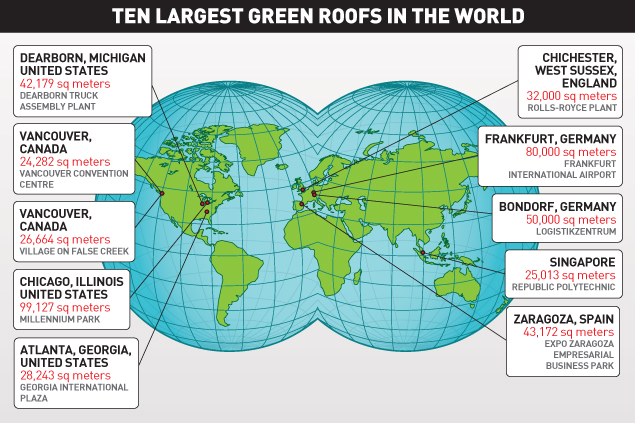 The 10 Largest Green Roofs
The 10 Largest Green RoofsGreen roofs are gaining acceptance in dozens of countries, joining other forms of green infrastructure that are being used to mitigate environmental problems of urban centers.
For example, vegetated roofs “are very good at managing stormwater. Most extensively planted green roofs will hold the first inch of rainfall and slow any additional rainfall, thus reducing peak flows and lowering the stress on combined sewer overflows,” says Steven Peck, founder and president of Green Roofs for Healthy Cities (CRHC).
 The group is a professional association with both corporate and individual members, ranging from large manufacturers to contractors, nurseries, landscape architects, structural engineers, roofing consultants and horticulturalists. "Stormwater management has been a driver [of green roof construction] in the U.S.," adds Peck.
The group is a professional association with both corporate and individual members, ranging from large manufacturers to contractors, nurseries, landscape architects, structural engineers, roofing consultants and horticulturalists. "Stormwater management has been a driver [of green roof construction] in the U.S.," adds Peck."The Environmental Protection Agency is working on rulemaking for municipal separate stormwater sewer systems (MS4s). It's very clear there is going to be a very significant green infrastructure component (green roofs and green streets)," says Nancy Somerville, executive vice president of the American Society of Landscape Architects.
Many cities throughout the U.S. and Europe have green-roof mandates or incentives in place. Stuttgart, Germany, requires green roofs on all new flat-roofed industrial buildings. In 2007, Pittsburgh enacted an law establishing stormwater volume reduction standards for properties greater than 10,000 sq ft, including on-site retention of the first inch of rainfall through any combination of infiltration, evapotranspiration and rainwater harvesting. Portland, Ore., requires new city-owned buildings and existing buildings in need of a roof replacement to install a green roof on at least 70% of the roof area.
Green Roofs for Healthy Cities' annual survey of its corporate members found that the green roof industry in the U.S. and Canada increased 115% between 2010 and 2011. The annual growth rate is derived by averaging the square footage of green roofs installed by a representative sample of corporate members.
"Increasing numbers of building owners in the public and private sectors are recognizing they can design, build and maintain green roofs profitably with a good return on investment," says Peck.

"Green roofs have a higher cost up front, but the payback over time is significant, not just in energy savings. It's protecting your roof membrane—you can skip one or two or three roof replacement cycles," says Somerville.
No comments:
Post a Comment